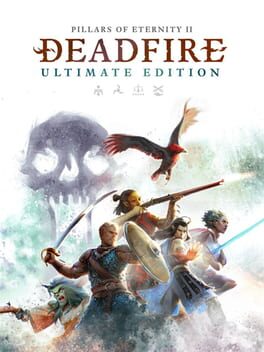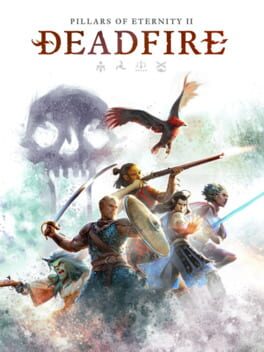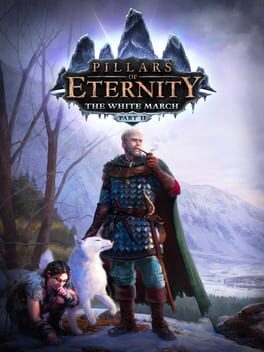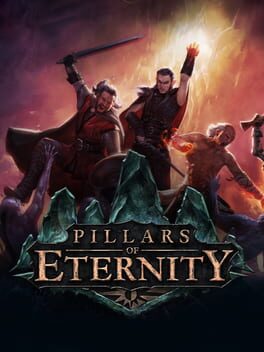

Pillars of Eternity II: Deadfire - Ultimate Edition
Obsidian Entertainment proudly presents the sequel to our crowdfunded and critically-acclaimed role-playing game, Pillars of Eternity. Welcome to Pillars of Eternity II: Deadfire. With Pillars II, we are revisiting the rich narrative, beautiful environments, and tactical combat that made Pillars of Eternity one of the highest-rated PC games of all time. The god Eothas awakens from his slumber, killing you and stealing a piece of your soul. Now resurrected, it is up to you and your companions to use magic, gunpowder, and steel to uncover the rogue god's machinations as he tramples across the Deadfire Archipelago. Bend the world to your will as you explore the depths of infinite possibilities, including detailed character customization, total freedom of exploration, and more meaningful choices at every turn. Featuring an enormous open world, a massive cast of characters, and a story you can play your way, Pillars of Eternity II: Deadfire Ultimate Edition redefines the role-playing game experience for a new generation. • Play in either Turn-Based Mode or Classic Real-Time with Pause: Immerse yourself in a deeper single player RPG game experience - now with both classic real-time with pause and new turn-based combat, Deadfire builds on the foundation of classic tabletop gameplay more than ever before. • A massive adventure: Over 100 hours of gameplay per playthrough. • Play however you want: Detailed character creator character and over 1000 class permutations gives you the freedom to be whoever you want. • Gather your party: Build your party and customize your companions to join you on your quest. Assign multiple classes and deeper abilities for each. Witness their personal relationships, reactions to player choice, and interactions with each other unfold. • Beast of Winter DLC - heed the call of Vatnir, a priest of the god of death, to halt the tide of destruction encroaching upon the living. • The Forgotten Sanctum DLC - battle your way through the bowels of a vengeful, sleeping god. • Seeker, Slayer, Survivor DLC - Triumph or die in the Crucible of Kazuwari, where only the mighty reign.
Also in series
Released on
Genres
Version
Ultimate Edition
Reviews View More
Monk class active abilities: Mortification of the soul, raised torment, stunning surge, swift fury, turning & iron wheel, skyward kick, the long pain, the dichotomous soul, launching kick, resonant touch, inner death & whispers of the wind. The most useful ones ended up being mortification of the soul, stunning surge, launching kick, skyward kick, resonant touch, & whispers of the wind.
The monk has two resources used for abilities, one that doesn't replenish in combat and another that fills as the monk takes damage. Mortification of the soul damages the monk and doing so fills the latter resource, but it costs 0 of the former resource. The damage it does is low enough that it's easily manageable, because of this, the monk can effectively use most of his active skills in combat without running out of resources. On top of that having resonant touch applies a passive bonus where the monk can activate resonance touch and every enemy that the monk has hit in combat takes a bunch of damage based on how many times they've been hit by the monk. Whispers of the wind is pretty much a flash move where the monk jumps from each enemy and hits all of them numerous times, in most combat encounters this means that the monk will clear the entire screen and damage everyone. You can easily spam this move each turn by just using mortification for a very small health loss for a big AOE move. For the enemies that don't die easily because they have huge health or armor, they're hit a lot which means they have a huge resonance score which means activating resonance touch leads to them taking huge damage.
In turn-based mode, knockdown & stun attacks are incredibly useful because they stack and make the enemy lose 1 or more turns. This is incredibly useful against enemies that can't be interrupted when they start casting a spell because they can still be knocked down. This is where launching kick and skyward kick are super useful, the former can cross the entire screen and will knock down all enemies in its path, and the latter can knock down any enemy I used it against that wasn't too high level.
By level 18 - max level, the monk is so OP that I can break through a lot of the game's combat fairly easily in turn-based mode. It was really fun and she was the big damage dealer and tank at the same time.
I wish the game allowed you to level up your party members when you're in the overworld, or when you're on your ship. It seems like a bizarre oversight. Would also be great to have auto-play for dialogue.
I do wish the game controlled better at times. I dislike the fact that they used the entire touchpad only for tutorials. This is a waste because tutorials only pop up whenever you encounter some new mechanic or system for the first time. Why not map the damn map or inventory to the touchpad? As it is now, you have to fucking go to the game wheel every time to bring either up.
Some good things out of the gate: There is a "fast" mode outside of combat that seems to double or triple game speed. There's a max of 1.8x game speed and a minimum of .5x speed choices in combat which means combat typically doesn't drag on with you watching slow animations. That's great.
I like the fact that you have an unlimited inventory and that you have area loot where you only have to click once to loot a pile of corpses. Though I wish there was an option to put loot within trash or favorite it.
Also, you can respec your skills & powers but can't respec attributes and class. It's good that you can do this in any tavern, it kind of sucks that the base traits can't be changed.
Most of the time your companion's skills can directly impact dialogue & scripted skill checks, or contribute to your skill stat for those skill checks. God, why don't more party RPGs do this? However, one baffling choice was the various scripted choices found on many of the islands where the game automatically uses your party member with the lowest attribute for that specific stat check. I don't think this is ever explicitly mentioned in the game, it's something I realized after save-scumming specific scripted encounters and noticed that the game constantly "failed" the stat check by checking the same companions even though I had others that had high enough attributes for the check.
On the bad side, the game still has many technical issues. 45 hours in, I had two crashes on PS5. Went up to 5 crashes 55 hours in. 40 crashes 100+ hours in. There are random freezes mid-game, though this is infrequent. There are times when the game will shuffle the order of save files so the latest save file isn't at the top. Many times you can't select any option in the menu wheel until you reload the game. When you enter sneak mode, and then leave, your character can't run anymore until you enter and leave sneak mode again. When you have too many buffs and debuffs on a character, it will block your options within the action bar during combat. There are areas in the game where enemies are invincible because they can't be targeted while they constantly attack the player. Outside of combat, when you switch to using the cursor, it locks onto a door and won't let you select the ground to move your party.
One huge issue in turn-based combat is the fog of war implementation. If combat is started in an area, all enemies are immediately aggroed, even those far outside the vicinity and those still in the fog of war. So what ends up happening is that the game will shuffle through every single enemy in the list and many times the enemies don't move, they're just invisible behind the fog of war and you end up waiting 30 seconds till their turn ends before you can do anything. I'd recommend playing the PC version because it likely has fewer technical issues than whatever this porting studio did.
In general, this game sits in a place where it really isn't too hardcore but not too simple either. You still have to rest to gain back many of your skills and heal your injuries, but you don't have too much restriction where your health automatically regens to max outside combat.
One thing that annoys me about certain isometric RPGs is when their mechanics don't consider the terrain or positioning. I'm in Engwithan Digsite and have a perfect opportunity to ambush a bunch of monsters while having the vantage point of being above them. The thing is that this game isn't one of those games where you can always attack enemies if you're a floor above or below them, many times you have to move to their level on the battlefield. It ruined my tactic of using Eder to just shoot the monsters with a bow and arrow because pressing attack forces him to move close to their position before he resumes the action. So it is fairly inconsistent in that manner.
Companion pathfinding still isn't great after. One of your companions can detect a trap yet the rest of them will still walk into the trap afterward. I swear there was a game that figured this out.
Turn-based combat again. A lot of times, the cursor will tell you that your party member can move in a certain direction, just for you to try moving there, then you can't because another party member is in your way, and all your movement points are wasted and your party member is forced to walk back to their original position.
As for the pirate motif, I quite enjoyed it. Not like there are many pirate/colonial period-based RPGs in the first place. There are a few ships you can purchase in the game, and they're all available for purchase after you get your ship. One of the more mixed things stated about this game is the text-based turn-based ship combat, it can seem complex because it has a different combat system than your typical party combat, however, I didn't think it was that bad. I do think it becomes too formulaic after a certain point. Once I learned that you just need to turn, fire cannons, and repeat this, ship combat became a bit braindead. It was smart that you could board ships from the get-go, intimidate, or flee with percentage chances but I think being able to just board a ship almost anytime when you're losing is a bit cheap because the enemies on ships tend to be weaker than what you typically encounter on the different islands and quests.
Combine this with the very large amount of bounty quests in this game, there are about two dozen, and you get a bit tired of "go here kill x person" quests.
The game has three major expansions, each focusing on a separate god and each has one of the sidekicks as a focus which is good on paper because the sidekicks are the companions with the least characterization, dialogue, and story presence in the base game. Beast of Winter focuses on rymrgand. Seeker, Slayer, Survivor focuses on Galawain. Forgotten Sanctum is based on Wael. Beast of Winter and Forgotten Sanctums are dungeon crawls while Seeker is mostly a series of repeatable combat arenas. I played all these when I reached the max level of 20 which was past the recommended level for each of them, but this didn't seem to be a big deal for Forgotten Sanctum because that expansion has the most difficult boss amongst the three expansions.
Beast of Winter felt like the story didn't go anywhere which was odd. We start with this weird cult of Rymrgand but most characters in there don't have much to say, only less than a handful have real dialogue and half of them are only focused on their small side quests. It just seems like the dialogue is inconsequential, the new godlike companion just reveals to us that he's a fraud who was never really in contact with his god and he fears the dragon that comes around killing their followers. They're a death cult waiting to die but this is less interesting by this point because there game has so many other gods that are more or less death cults in the form of Berath - who we work for - and Eothas - who is the main antagonist. After that, we fight a fairly easy dragon fight and then we're told by Rymrgand to kill the dragon because the dragon has found a way to make itself immortal and rymrgand can't kill it. The interesting content of this expansion comes after this when we enter the beyond and we experience three important parts of Pillars of Eternity lore with the death of Saint Waidwen, the partial fall of Ukaizo, and some of Engwith. You don't have to do this, but completing them allows you to bring in up to three spirit companions that can weaken the dragon boss. It's great content and not intensively combat-focused if you care about Pillars lore and by this point, I was interested in it. Afterward, it led to a boss fight with the dragon that was lackluster to me. The dragon has a big health bar but doesn't deal too much damage and gets knocked out easily against the monk's skyward kick. After beating we just go meet Rymrgand he doesn't thank nor reward us and tries to force us to join his covenant which doesn't have any real consequence throughout the game. I ended up fighting his avatar and winning but the consequences are still the same. Going back to the cult village all of them are still there and our godlike companion just tells them all to keep following their faith.
Seeker I have less to say. There are over a dozen combat arena fights but at this point, they were all far too easy and they rehash enemies we've fought throughout the base game. Seeker also abuses something quite terrible within turn-based mode and that's having numerous enemy waves that spawn mid-combat and ruin the turn order mid-turn. At least the final boss of the DLC was quite a challenge.
Forgotten Sanctum is a much bigger dungeon crawl than the rest and takes place in one underground hall. I quite liked all the Vistas, it has more involved quests than the other DLCs, and on top of that, this DLC is more intimately connected to the other characters and quests in the base game, specifically the archmages, and Eothas because it allows you to have a different major ending. In terms of combat, this one has the most difficult final boss of the three DLC. The other combat encounters are more annoying though.
As for the mega battles, I dislike their length. There are 5 of them, all optional though one is optional depending on the story choices you make since it is the final boss of the game. The other four have higher levels than the max player level of 20 and all have incredibly high armor & defense, but each will drop a mythic gem that can upgrade items past legendary. Since there are only 4 gems you can get at max then you can only upgrade 4 items past legendary. I ended up fighting three of them. The first one I beat was sigilmaster auranic.
This boss is overall designed poorly. She has a bit lower defenses than the others but her combat room has 5 obelisks. Every few turns she will activate one of the obelisks and they come with an effect that applies to your entire party regardless of where they are in the arena. My issue with this fight is that it bends many of the rules we come to expect throughout the game. I died against her once so I restarted the fight and rested prior with some high-level food. I ended up approaching the fight by cornering her and constantly using skyward kicks and mule kicks. This is important because both abilities knock her down which means she skips a turn which means she can't cast her spells nor activate the obelisk. I ended up beating her down to 0 health doing this, then the problem hit me. She doesn't die with 0 health, the game won't let her do so. So while she's knocked down with zero health, the game will make her stand up, activate all the obelisks at once, and then immediately kill her. What a crock of bullshit. You can't win this fight by defeating her using an intelligent tactic, the game will force you to do otherwise and force you to fight all the obelisks which spam unblockable moves that will hit all party members regardless of where they are in the arena.
Next was the crystal spider, like Aurania this is also an endurance fight that lasts over an hour. The spider has very high armor and defenses and 8 smaller spiders spawn frequently. Killing the smaller spiders reduces the defenses of the big crystal spider. Even at max level the crystal spider still has defenses that make it borderline impossible to land a hit. Just like the other mega bosses, it has attacks that do multiple hits to one character in a single turn which all the other enemies don't have. In any case, this one is easier because the small spiders do little damage and die easily. However, to bring down the defenses of the crystal spider to an appreciable point, you have to kill 80 - 120 small spiders. Yes, it's that tedious in the turn-based mode because the fight now becomes extremely long and boring.
The final mega-boss I fought was the guardian of Ukaizo. This one is more interesting because it exists within the story proper. The gods warn you that the guardian guards Ukaizo and will kill anyone who tries going there, and Ukaizo is the final location of the game. This fight was also long and the boss had numerous immunities. As it goes down from healthy > hurt > bloodied > near death, it will summon other tough enemies to aid it in combat. This one had the stronger minions of all the final bosses because of the titans and powerful mages it brought. It's also a three-headed mecha dragon which means its design is cooler than the other megabosses. Unfortunately, there is no good reward for fighting this boss in terms of loot. Eothas will mention that you defeated the guardian after the fact but that's just one sentence of dialogue. Due to that, this is the real final boss of the game, but apparently, I only fought it because I decided to go to Ukaizo without allying myself with either the Principi, Huana, Valian, or Rautai. It surprised me because I didn't expect this fight at this point.
I was disappointed with how little dialogue most companions and all sidekicks have throughout the entire game and also the flow of conversations when companions decide to say something. You can complete most companions' story quests by the early-mid portion of the game, afterward most don't have anything else to talk about if you initiate a conversation with them. This is even worse when exploring the world because most companions just don't say anything. I could tell that the developer's favorites were Eder, Ydwin, Xoti, and maybe Pallengina and Aloth. Two of these were in the first game so it makes sense. The former three have a large amount of dialogue but in conversation and exploring the world. Shockingly Ydwin is only a sidekick but she has a lot to say about the expansions and the base game. She ended up being one of my favorite companions.
So that's the finale of Pillars of Eternity 2 for me. It was an incredibly long and bumpy ride. I had a lot of complaints about the length of this game, which I think is likely alleviated by playing in real-time instead of turn-based mode, it's unfortunate you can't switch between both after starting a new game.
I had complaints about the easiness of this game, but it seems Obsidian tried alleviating this with one expansion and 5 optional mega-bosses. I think this would've been better if these mega bosses weren't pushed off to the very end of the game.
There are far too many technical issues with the console version.
The game has great-looking environments but the dungeon crawling and combat leaves much to be desired. The base mechanics make the former typically too easy, and turn base mode makes the latter too tedious. However, some of this can be alleviated due to the large amount of "difficulty" options that are available to the player. However, most of those difficulty options will only open up to the player after they've beaten the game. Will I replay the game on harder difficulty to try this anytime soon? No.
While the story is heavily focused on the divine, religion, colonization, & politics, the companions are incredibly dry in this game and many story threads end in an unsatisfying manner. The last point will matter more depending on how much you accept the futility of going against the gods.
...but the world is so immersive, the different ways you can do quests or storylines, all the new people and places, and choices from PoE1 that impact the second one make it an excellent isometric RPG to play for fans of the genre and newbies alike. Be warned though, you will get the shanties stuck in your head forever...




